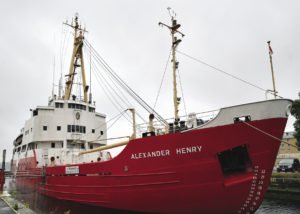“Bring Back the Alexander Henry” is the rallying cry heard loud and clear these days in Thunder Bay. The former Canadian Coast Guard icebreaker built in Thunder Bay—which has been a ‘museum ship’ of the Marine Museum of the Great Lakes in Kingston, Ontario since 1985—faces an uncertain future of being either sunk or scrapped now that the museum’s property has been sold. That is, unless the ship can be brought back ‘home’ to Thunder Bay, and the Lakehead Transportation Museum Society (LTMS) is working to make that happen.
The Alexander Henry was built in 1958 at the former Port Arthur Shipbuilding Co. Ltd. It was named after British-Canadian Alexander Henry ‘The Elder’ (1739-1824), an explorer and pioneer fur-trader who for a time controlled the Lake Superior fur-trade and later became a partner in the fur-trade’s North West Company.
The Henry was commissioned in 1959 as an icebreaker and buoy tender for the Canadian Government’s Department of Transport Marine Service and transferred in 1962 to the newly-created Canadian Coast Guard. The Henry is 197.8 feet (60.29 metres) in length, a beam of 43.6 feet (13.29 metres), draught 17.91 feet (5.46 metres), and has a massive derrick for lifting five-ton buoys in and out of the water.
Back in the 1960s to early 1980s, the red-and-white Alexander Henry would arrive each spring to break ice in the Thunder Bay Harbor for the shipping season.
“The Henry is an iconic image of our rich transportation heritage. Thousands of residents would wait and watch for the Alexander Henry to arrive to bring in the new shipping season. It was big event,” said Charlie Brown, president of LTMS.

The Henry also shuttled lighthouse keepers from Thunder Bay to their stations each spring as the ice was moving out and picked them up at the end of navigation season. In 1961, the Henry was equipped with a helicopter on board and began its “marine-aerial” service. The icebreaker would anchor offshore from the lighthouse and the helicopter flew the keepers, their families and supplies from the Henry to the station. By the 1980s, the transfers were made directly from Thunder Bay by Canadian Coast Guard helicopter.
After 25 years of service in the Lake Superior region, the Henry was decommissioned in 1984 when the Canadian Coast Guard’s new icebreaker Samuel Risley was put in service. A year later, in 1985, the Henry was sold to the Marine Museum of the Great Lakes and put on display, becoming a popular tourist attraction in Kingston as well as a B&B. At the time, many believed the ship should have stayed in Thunder Bay, but local efforts failed to keep it. Here’s what appeared in the Thunder Bay Chronicle-Journal editorial on July 19, 1985:
“Not only has the retired government icebreaker Alexander Henry already been delivered to Marine Museum of the Great Lakes at Kingston, there is now a tea room on board with students manning the galley. With tables and chairs on her deck, the Henry has become a key attraction at the museum dry dock, just the way it would have been at Thunder Bay’s Prince Arthur Landing marina…More could have been done—more noise made—but the collective will did not seem to be here.”
Now there’s a second chance to bring back home the Alexander Henry.
It came about as a result of the sale of the Marine Museum’s property by the Canadian government to a private developer (museum had been located on the waterfront there for 40 years). Talks for a new rental deal between the museum and new owner fell through, and the museum, including the Alexander Henry, had to move out by August 23.
The Henry was moved by tugboat out of dry dock and Doornekamp Construction arranged for the ship to be temporarily moored near Picton, Ontario. The museum’s options became limited—either sink it as an artificial reef for recreational diving or turn it over to the Doornekamp with the real possibility the ship would be cut up for scrap.
Interest is high in Thunder Bay to save the Henry and get her back to the port of birth. The LTMS and the Marine Museum have been negotiating for the past three months and things look positive. According to Brown, the cost to tow the Henry to Thunder Bay is around $250,000.
“We’ll soon be launching activities to raise the funds and look for community support to bring home an important part of Thunder Bay’s marine transportation heritage,” said Brown.
LTMS memberships are now available at $25 individual/$35 family, and a special “Alexander Henry Dinner” is planned for February 4, 2017 at the Prince Arthur Hotel.
As a Thunder Bay resident, many of us have always considered the Alexander Henry as “ours.” In a recent Letter to the Editor in the Chronicle-Journal, Kingston resident Marjorie Burggra, a 30-year volunteer at the Marine Museum, wrote that Thunder Bay people entering the museum would say, “You have got our ship! We want it back!”
The editorial on September 16 in the Chronicle-Journal said it well, “Thunder Bay has yet another opportunity to reclaim a piece of its transportation heritage. Let us not waste this one…Can we do it?”



